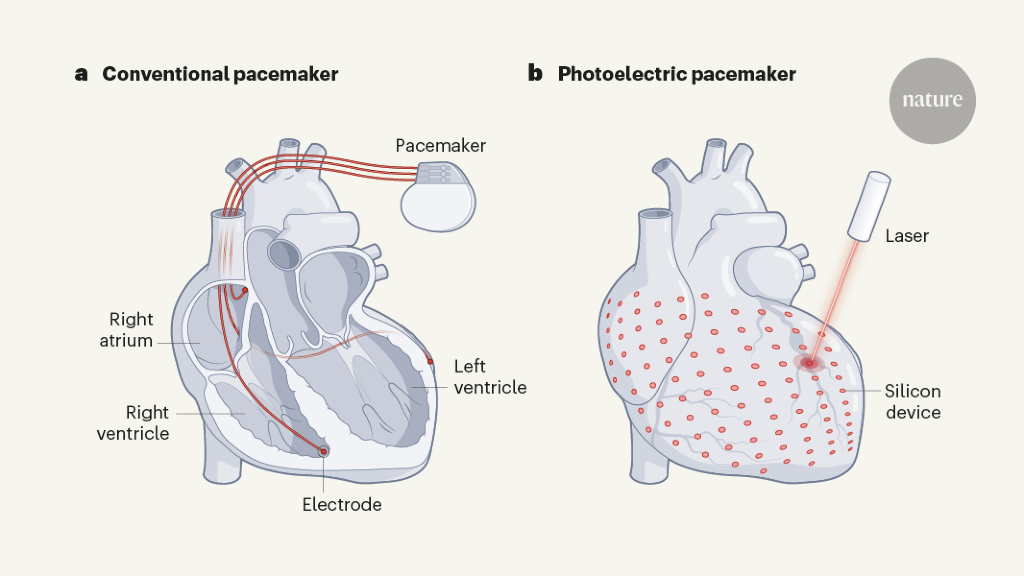Using Light to Stimulate the Heart's Rhythm
Core Concepts
The authors propose a novel technique utilizing light energy to stimulate the heart as an alternative to traditional pacemakers, addressing issues such as battery life and interference.
Abstract
Life depends on the heart's rhythm set by the sinus node. Traditional pacemakers face limitations, but a new technique using light energy could revolutionize cardiac stimulation, as discussed by Li et al. in Nature.
Light can restore a heart’s rhythm
Stats
This regular rhythm is set by the body’s natural pacemaker: a collection of cells known as the sinus node.
Standard pacemakers are powered by electrochemical batteries that have a limited life.
The devices are prone to electrode failure and interference from external electromagnetic fields.
Quotes
"Writing in Nature, Li et al. present a technique that uses the energy from light to stimulate the heart."
Key Insights Distilled From
by Igor R. Efim... at www.nature.com 02-21-2024
https://www.nature.com/articles/d41586-024-00303-5
Deeper Inquiries
How can this light-based cardiac stimulation technique impact patients' quality of life?
The use of light-based cardiac stimulation techniques can significantly improve patients' quality of life in several ways. Firstly, by utilizing energy from light to stimulate the heart, this approach eliminates the need for traditional electrochemical batteries found in standard pacemakers. As a result, patients no longer have to undergo frequent surgeries for battery replacements, reducing the associated risks and complications. This leads to a more convenient and less invasive treatment option for individuals with heart rhythm disorders. Additionally, the reduced risk of electrode failure and interference from external electromagnetic fields enhances the reliability and effectiveness of the device, ensuring consistent and accurate heart rate regulation. Overall, this innovative technique offers a promising solution that can enhance patient outcomes and overall well-being.
What potential challenges or drawbacks might arise from adopting this new approach over traditional pacemakers?
While light-based cardiac stimulation presents numerous benefits, there are also potential challenges and drawbacks associated with its adoption over traditional pacemakers. One significant concern is the novelty of this technology, which may lead to initial skepticism among healthcare providers and patients regarding its safety and efficacy compared to established methods. Additionally, there could be limitations in terms of accessibility and affordability as implementing such advanced medical devices may require specialized training for healthcare professionals and incur higher costs initially. Furthermore, long-term studies are needed to assess the durability and sustainability of these light-based systems over time compared to conventional pacemakers. Addressing these challenges will be crucial in ensuring a smooth transition towards widespread adoption of this innovative approach.
How might advancements in light-based medical technologies influence other areas of healthcare?
Advancements in light-based medical technologies have the potential to revolutionize various aspects of healthcare beyond cardiac stimulation applications. For instance, optical imaging techniques such as optical coherence tomography (OCT) have already transformed diagnostic procedures by providing high-resolution images for early disease detection in ophthalmology and cardiology fields. The integration of light-activated therapies like photodynamic therapy (PDT) has shown promise in treating certain types of cancer by targeting specific cells without causing extensive damage to surrounding tissues.
Moreover, optogenetics—a field that combines genetics with optics—has enabled researchers to control cellular activity using light-sensitive proteins, offering new insights into neurological disorders like Parkinson's disease or epilepsy.
Overall,
the continued development
of
light-based medical technologies holds great potential
to advance precision medicine,
improve treatment outcomes,
and drive innovation across diverse specialties within healthcare sector
0
